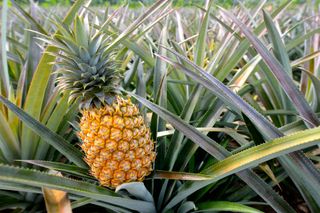How Much Vitamin C Does Pineapple Have
Pineapple: Nutrition Facts and Health Benefits

Pineapples are tropical fruits that are rich in vitamins, enzymes and antioxidants. They may help boost the immune system, build strong bones and aid indigestion. And, despite their sweetness, pineapples are low in calories.
Pineapples are members of the bromeliad family, and are the only bromeliad that produces edible fruit, according to the Purdue University Center for New Crops and Plant Products. The fruit is made of many individual berries that grow together around a central core. Each pineapple scale is an individual flower, or berry.
The nutritional benefits of pineapples are as attractive as their unique anatomy. "Pineapples contain high amounts of vitamin C and manganese," said San Diego-based nutritionist Laura Flores. These tropical fruits are also a good way to get important dietary fiber and bromelain (an enzyme).
"As well as having high amounts of manganese, which is important for antioxidant defenses, pineapples also contain high amounts of thiamin, a B vitamin that is involved in energy production," Flores said.
For all its sweetness, one cup of pineapple chunks contains only 74 calories, according to the USDA National Nutrient Database. Pineapples are also fat-free, cholesterol-free and low in sodium. Not surprisingly, they do contain sugar, with about 14 grams per cup.
Nutrition facts
Here are the nutrition facts for raw pineapple, according to the U.S. Department of Agriculture:
Serving size: 1 cup chunks (165 g)
Amount per serving:
Calories 74
Total Fat 0 g
Cholesterol 0 mg
Sodium 2 mg
Potassium 206 mg
Total Carbohydrate 19.5 g
Sugars 13.7 g
Protein 1g
Vitamin C 28 mg
Calcium 21 mg
The nutritional profile for canned pineapple is different from raw pineapple. According to the USDA, canned pineapple is typically higher in calories and higher in sugar. It also contains fewer vitamins and minerals. If you do opt for canned pineapple, try to get it with no added sugar or look for a variety that is canned in fruit juice instead of syrup.
Health benefits
Pineapple contains a significant amount of vitamin C, a water-soluble antioxidant that fights cell damage, according to the Linus Pauling Institute at Oregon State University. This makes vitamin C a helpful fighter against problems such as heart disease and joint pain.
Pineapple may help you keep standing tall and strong. One cup of raw pineapple chunks contains 2.6 mg of manganese, a mineral that's important for developing strong bones and connective tissue, according to the Linus Pauling Institute. A 1994 study suggested that manganese, along with other trace minerals, may be helpful in preventing osteoporosis in post-menopausal women.
The variety of vitamins and minerals in pineapples have many other health benefits, too. For example, "pineapples can help reduce the risk of macular degeneration, a disease that affects the eyes as people age, due in part to its high amount of vitamin C and the antioxidants it contains," Flores said.
Like many other fruits and vegetables, pineapple contains dietary fiber, which is essential in keeping you regular and in keeping your intestines healthy, according to the Mayo Clinic.
But unlike many other fruits and veggies, pineapple contains significant amounts of bromelain, an enzyme that breaks down protein, which may help with digestion, according to the American Cancer Society. Multiple studies have suggested that bromelain could also be helpful in treating osteoarthritis.
Excessive inflammation is often associated with cancer, and according to the Memorial Sloan Kettering Cancer Center, bromelain and other proteolytic enzymes have been shown to increase the survival rates of animals with various tumors.
Flores noted that because of their bromelain levels, pineapples can help reduce excessive coagulation of the blood. This makes pineapple a good snack for frequent fliers and others at risk for blood clots.
In addition to having lots of vitamin C, pineapple's bromelain may help reduce mucus in the throat and nose, according to the University of Maryland Medical Center. So if your cold has you coughing, try some pineapple chunks. Those with allergies may want to consider incorporating pineapple into their diets more regularly to reduce sinus mucus long term
Health risks
"Because pineapple is a great meat tenderizer, eating too much can result in tenderness of the mouth, including the lips, tongue and cheeks," Flores said. "But, [it] should resolve itself within a few hours." But if the feeling persists, or if you experience a rash, hives or breathing difficulties, you should seek medical help immediately, as you could have a pineapple allergy.
Flores pointed out a possible negative to pineapple's high levels of vitamin C. "Because of the high amount of vitamin C that pineapples contain, consuming large quantities may induce diarrhea, nausea, vomiting, abdominal pain or heartburn," she said.
Additionally, extremely high amounts of bromelain can cause skin rashes, vomiting, diarrhea, and excessive menstrual bleeding, according to the University of Maryland Medical Center. Bromelain can also interact with some medications. Those taking antibiotics, anticoagulants, blood thinners, anticonvulsants, barbiturates, benzodiazepines, insomnia drugs and tricyclic antidepressants should be careful not to eat too much pineapple.
Eating unripe pineapple or drinking unripe pineapple juice is dangerous, according to the horticulture department at Purdue University. Unripe pineapple toxic to humans and can lead to severe diarrhea and vomiting. And, avoid eating too much of the pineapple core as it could cause fiber balls to form in the digestive tract. [Quiz Yourself: Pineapple Nutrition Facts]
Additional resources:
- Read more about pineapple and find pineapple recipe ideas from Berkeley Wellness, a project from the University of California Berkeley.
- Learn more about this edible bromeliad and other bromeliads on bromeliads.info.
- Find out more about the social history of pineapples from Encyclopedia Britannica.
This article was updated on June 26, 2019 by Live Science Reference Editor Kimberly Hickok.
How Much Vitamin C Does Pineapple Have
Source: https://www.livescience.com/45487-pineapple-nutrition.html







Tidak ada komentar:
Posting Komentar